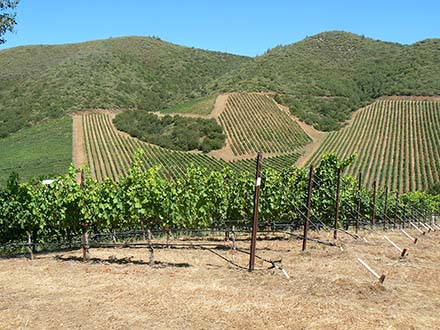Calaveras Winegrowers Seek AVA Status

Calaveras
About 70 people, mostly local growers and vintners, attended the daylong tour, which visited six vineyard properties. Attendees learned more about new varieties being planted and the challenges and benefits of grapegrowing in the county. The tour is organized and presented by CWA along with the University of California Cooperative Extension. Extension viticulture specialist Dr. Jim Wolpert of the University of California, Davis, presented information from his statewide perspective to accompany comments and information from Collum and the vineyard owners at each location. Scott Oneto, extension farm advisor for Calaveras and Tuolumne counties, who recently assumed viticulture duties after the retirement of long-time county farm advisor
Collum, a former vineyard manager with Kendall-Jackson, in
Calaveras vineyards range in elevation from about 200 feet to 3,300 feet. Vine and wine production include traditional varieties such as Chardonnay, Sauvignon Blanc, Cabernet Sauvignon, Cabernet Franc and Merlot. Calaveras also has dry-farmed, old vine Zinfandel (commonly associated with the Sierra Foothills) at the Ghirardelli Vineyard, a portion of which is more than 100 years old.
During the past 10-15 years, newer vineyards have seen more varietal diversification with a move toward Rhône, Italian and Iberian varieties such as Syrah, Mourvèdre, Petite Sirah, Grenache, Barbera, Sangiovese, Tempranillo and Graciano for reds, and Viognier, Marsanne, Roussanne, Pinot Grigio, and Albariño for whites. Collum explained, "We haven't been pigeon-holed for Zinfandel as in some Sierra Foothills locations, so we can try new things."
Many Calaveras wineries are boutique operations that sell wines direct through local tasting rooms and wine clubs. The CWA promotes 23 tasting rooms, most in and near Murphys. The county is a tourist getaway destination for Gold Rush history and wine tasting, and a stop for visitors enjoying summer and winter recreation in the
Open to experiment
An example of the move to try new varieties is the 9-acre Clondaire Vineyard west of San Andreas. Owned by Bill and Antoinette Griffin, the rocky property with scattered oak trees and a view of the
Collum said, "I'm a big proponent of planting varieties for the climate and location, and we now have many new options available (through grapevine nurseries and Foundation Plant Services), so we're in the process of discovering what works up here."
Wolpert, who has made recent trips to
Grower Jim Dalton moved to Calaveras County 10 years ago after looking for property to grow grapes in
Describing a unique aspect of the Calaveras wine experience for consumers,
The 60-acre Dragone Ranch, perhaps the county's most topographically dramatic vineyard, is planted to 16 different varieties, and ranges in elevation from about 1,600 to 2,000 feet with hillside slopes of 20% and more. Dragone was originally planted in 2000 by former vineyard and winery owner Barden Stevenot, with consultation from Collum. Stevenot Winery was the first major post-Prohibition winery in the county when it was started in the 1970s.
The Stevenot family sold the property and winery in 2006. The subsequent owner filed bankruptcy in 2009. The Dragone Ranch is currently owned by lender Bay-Sierra Financial Inc., but still is managed by Collum, and the grapes are sold to local wineries. The warmer, more exposed higher locations in the vineyard have varieties such as Syrah, Barbera, and Petite Sirah, but the lowest and coolest area near the bottom of the drainage can produce Pinot Noir. Other varieties planted here include Merlot, Cabernet Sauvignon, Grenache, Pinot Grigio and
Winemaker Chuck Hovey, who started Hovey Wine Consulting in 2007, makes wine for several Calaveras brands including his own. He probably has more experience working with Dragone fruit than anyone, because he was the Stevenot winemaker for 24 years. Hovey was one of the first winemakers in the county to produce Tempranillo.
Hovey said, "We tend to get grapes with high pH due to high temperatures, but we blend in Graciano that maintains a lower pH and has a brightness that lifts up the Tempranillo to give it better depth." Hovey also will be making wines for the Stevenot label again, as the Stevenot brand, wine club and Murphys tasting room were acquired earlier this year by the Oliveto Family of Oliveto Distributing, which has distributed Stevenot wines since the 1980s.
Other vineyards visited during this year's CWA tour were Gerber Vineyard, the county's largest at 93 acres; the 300-case artisan Ayrael Vieux Vineyard & Winery, a 2-acre vineyard planted in 2004 with Sangiovese, Montepulciano and head-trained Zinfandel; and 850-case Broll Mountain Vineyard, which produces 100% estate- grown ultra-premium wines from its 12-acre vineyard.
The tour enabled attendees to ask questions about viticultural issues of concern in the area, including frost protection, soil nutrition, gopher control, preventing crop loss to birds, weed control in both organic and conventional vineyards, rootstocks, pruning, trellising, and irrigation. As in most of
Wolpert, who has participated in several Calaveras Vineyard Tours, praised the CWA and the

